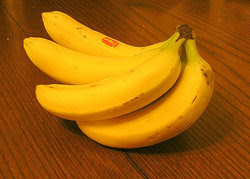Source: Answers.com , November 14, 2007
This banana probably looks very familiar to you. It should because “100 billion Cavendish bananas consumed annually worldwide,” and it is America’s number one choice of fruit. Many of us take this wonderful fruit for granted. However, we should enjoy them while they last, because there is a chance that the Cavendish banana population will be wiped out completely. This may be hard to believe, but this is actually not the first time that bananas have faced extinction.
Up until the 1950’s a banana called the Gros Michel, or “Big Mike,” was the most popular banana type. It was apparently larger, and tastier, then the bananas that fill our homes today. Unfortunately, all the Big Mike banana
populations were wiped out by the Panama disease, which is caused by the Fusarium oxysporum fungus.
Fortunately, for the last 50 + years the Big Mike has been replaced by the bananas that we find in our homes today. They are a Chinese variety called the Cavendish, that were able to resist the disease. However, the very popular, inexpensive, and delicious fruit, may not be around for much longer because in the last thirty years a new disease, called the Black Sigatoka has been wiping out bananas crops everywhere, and not only Cavendish bananas. Other types of bananas in Asia, Africa and Latin America have been affected by the disease. The disease is having a major impact on the banana industry. Banana crops are being cut in half, and farmers have to use more fungicides to try and fight of the disease. Farmers may have to”spray their plantations up to fifty times a year! (gmo-compass.org)” This is costly, harmful to the environment, and to the health of the employees that harvest the fruit. One serious issue is that the major use of fungicide is actually creating ‘super fungus.’ The fungus that is destroying the banana crops is at an advantage because it has a very short generation times, which allow them to adapt quickly, and create new generations of fungi that are resistant to the fungicide treatment.
The Black Sigatoka is not the only thing threatening the banana population. It is actually a combination of things. One huge contributor to the doom of bananas as we know them, is the fact that Cavendish bananas are pathenocarpic.
Parthenocarpy
-The forming fruit without fertilization
The fruit of parthenocarpic plants are seedless, which is relatively rare among plants. Most cultivated bananas are parthenocarpic. Genetic engineering has been used to create seedless varieties of tomato, strawberry, raspberry, and eggplant. – (http://www.gmo-compass.org/eng/glossary/52.parthenocarpy.html)
So why is parthenocarpy a problem?
“Rather than forming seeds, bananas reproduce by forming side-shoots and suckers. This means that the gene pool of bananas never really changes over the generations. This is a major restriction to breeding possibilities: all efforts to introduce fungus resistance to Cavendish bananas through conventional breeding methods have failed (http://www.gmo-compass.org).”
Don’t be too quick to kiss the banana goodbye… there is still hope! With the useless effort to fight off fungus with fungicide, many banana producers are now hoping that genetic engineering can save the Cavendish bananas (and they might not be putting their bananas in the wrong basket).
“Last year a group of scientists announced that they would completely sequence the banana genome. They intend to focus particularly on banana varieties found in nature. Wild bananas can reproduce by seeds and are constantly confronted with fungi and other pathogens. Sequencing the genome should enable researchers to discover resistance genes that could be transferred to high-yielding, seedless varieties (http://www.gmo-compass.org).”
Many people have declared their love for bananas in song. One song that came out during a banana famine in 1923 was entitled, “Yes! We have no bananas.” Below is a link to a recreation of this 1923 hit, sung by the loveable Muppets.
Yes, we have no bananas- Muppet recreation : http://www.youtube.com/watch?v=B78rrwSQB24
Sources:
http://www.popsci.com/popsci/science/5a4d4c3ee4d05010vgnvcm1000004eecbccdrcrd.html
http://www.gmo-compass.org/eng/grocery_shopping/fruit_vegetables/17.bananas_using_genetic_engineering_against_fungal_disease.html
http://www.youtube.com/watch?v=B78rrwSQB24
Saturday, November 17, 2007
Subscribe to:
Post Comments (Atom)



2 comments:
I remember this from a while ago, 2003 perhaps?
http://www.snopes.com/food/warnings/bananas.asp
As the Snopes article points out, the only banana's in danger are the industrial variety. Thus, organic Bananas with a wider diversity, could replace the Cavendish when they are wiped out.
As the saying goes, whatever doesn't kill the species, makes it stronger.
Very interesting blog post, very informative and original....I am asking for more! Thanks
Post a Comment